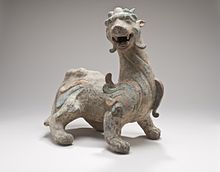Bixie

A Bixie (Chinese: 辟邪; pinyin: bìxié, Wade–Giles: Pi-hsieh; Japanese: 辟邪, へきじゃ, Hekija) is a type of lion-like mythological Chinese creature, or chimera. It is considered as an exorcising animal (辟邪 literally means "Avoid Evil") and is usually hornless.[1][2] See also Pixiu.
The Bixie can have a pair of wings, which makes it rather similar to the Tianlu (Chinese: 天禄, Japanese: 天禄, てんろく, Tenroku) in following early Chinese sculptural traditions of winged celestial beasts.[1]
The Bixie may have been an adoption from Mesopotamian art, through Persia and Bactria, as a consequence of extensive trade relations initiated by Emperor Han Wudi during the Han period.[3]
Some western scholars of Chinese art use the word "chimera" generically to refer to the bixie, qilin, and tianlu.[4]
-
Celadon from the Western Jin period (265-317)
-
Sculpture in the Shanghai Museum
-
Stone statue from Luoyang during the Eastern Han period (25-220)
See also
Notes
- ^ a b Chinese sculpture By Angela Falco Howard p.56
- ^ Text and ritual in early China By Martin Kern p.56
- ^ China: a history By Harold Miles Tanner p.129
- ^ Barry Till (1980), "Some Observations on Stone Winged Chimeras at Ancient Chinese Tomb Sites", Artibus Asiae, 42 (4): 261–281, JSTOR 3250032



